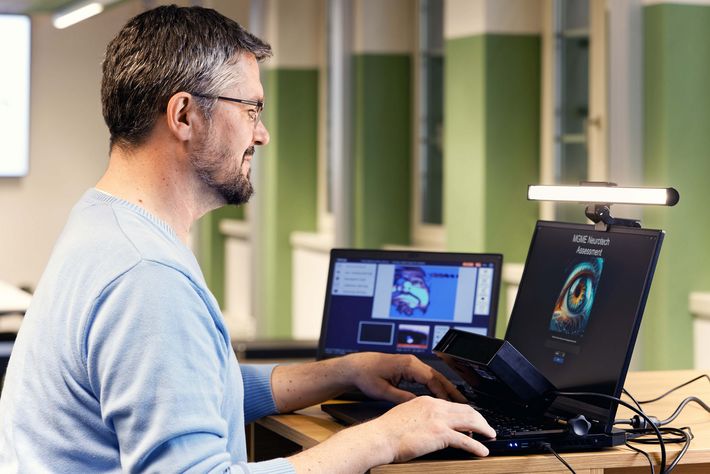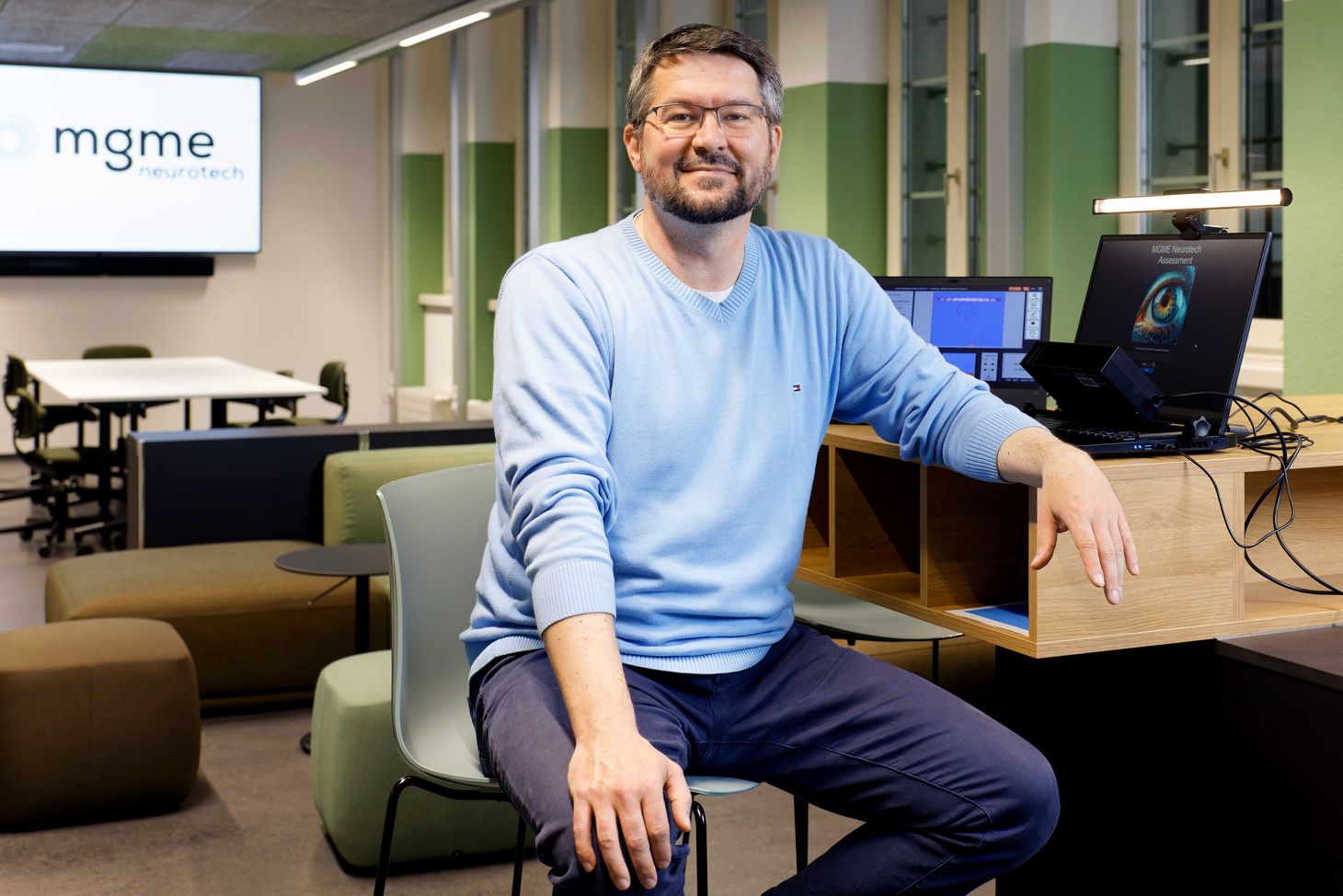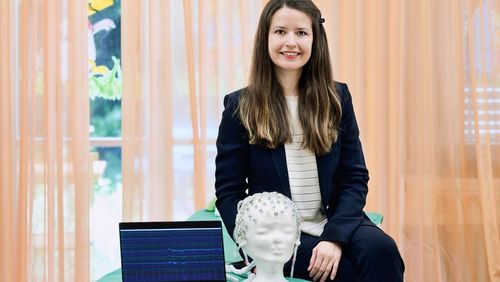Reading stress in our eyes
Our susceptibility to stress can be seen in how our pupils react. This understanding is at the core of a method developed by Marcus Grüschow—neuroscientist and recipient of a MedTech Entrepreneur Fellowship from the University of Zurich—to help people deal better with stress.
Chronic stress is widespread. Indeed, according to Switzerland’s 2022 “Job Stress Index”, more than twenty-eight percent of all employees report high levels of stress at work. Aside from causing personal hardship, the situation also has financial consequences. “Stress-related problems like anxiety, depression and burnout are now the main reasons for people to miss work—in Switzerland and the rest of the world, too,” says neuroscientist Marcus Grüschow. “Treating these conditions is extremely complex and expensive.”
Now, however, Grüschow has developed a method that has the potential to prevent stress from happening in the first place. The initial step in the process was a study he conducted several years ago at the University of Zurich Department of Economics. “We wanted to find out what makes some people resilient to stress,” he explains. Animal testing had already revealed that rats and mice with hypersensitive stress systems (also known as “arousal systems”) in the brain are more likely to suffer from stress, anxiety or depressive symptoms.
In their study, Grüschow and his research colleagues examined medical students who were at the time completing a six-month internship at a hospital accident and emergency department. “It’s an extremely stressful setting, and we hypothesised that people with more sensitive brain arousal systems would have a higher propensity for developing anxiety or depressive symptoms.” To measure their brain arousal systems, the researchers examined the medical students using magnetic resonance imaging—but also with an eye tracker.

Reading stress in the pupil
For one, the study did indeed demonstrate that pupil dilation mirrors the neuronal firing rate in the brain and thus provides a window onto the brain’s reaction to stressful situations. For another, it also confirmed that students with sensitive arousal systems are indeed more likely to present anxiety and depressive symptoms after their internships. “I realised that we had discovered something important,” Grüschow says. “We had scaled down the method to predict stress susceptibility from a machine that costs millions—the MRI—to a small eye tracker, later even to a webcam.”
On the basis of this simple detection method, Grüschow and a colleague founded the start-up MGME Neurotech in 2021. However, a prediction tool alone doesn’t make a successful business model. So, to further develop the method, Grüschow applied for—and was awarded—a MedTech Entrepreneur Fellowship at the University of Zurich, a programme that receives financing from the Werner Siemens Foundation. Thanks to the fellowship, he was able to conduct another study with the aim of using feedback from the eye trackers to help people train and improve their emotional self-regulation.
A total of forty test persons took part in four training sessions during which they viewed images that can cause stress to register in the brain. “The images were repellent and upsetting: burn victims, wounds and starving children as well as spiders, snakes and snarling dogs,” Grüschow says. After being instructed in strategies to regulate stress, the test subjects were asked to reduce their stress levels as quickly as possible after viewing the images.
Once again, how well each person would deal with the images was predicted using the pupil marker. In addition, each test subject received feedback on how well they regulated their brain arousal system. In half the cases, the information was factual, in the other half, it was fictionalised, but in such a way that the participants didn’t realise that a study control was being carried out. Over the course of the next three months, the test subjects endeavoured to incorporate emotional self-regulation in their daily lives. Every other day, they also completed a mini-questionnaire via an app to report on their anxiety levels, depressive symptoms and general mood.
Sensitive test subjects benefit most
The findings showed that emotional self-regulation in the test subjects who received factual feedback improved at a higher rate than in those who received pseudo-feedback. In addition, the researchers found that training and feedback was most effective in participants who were highly susceptible to stress. “People who are vulnerable to stress need quite a bit of time to recover from charged situations like examinations. They also already start presenting anxiety and stress symptoms days beforehand,” Marcus Grüschow explains. “With our training, however, their ability to deal with these fears improved over time.”
In contrast to the stress-sensitive participants, test subjects who were already resilient to stress made only negligible improvements over the three-month period. The researchers believe this is because these individuals already have good tools for coping with stress. Related strategies include reframing a situation: when we’re stuck in a queue, we can try to find something positive in the experience—for instance, we could look at it as an opportunity to let our minds wander for a few minutes.
Another possible strategy is creating some distance to a stressor. If we’re having an argument, sometimes it’s better to step away and take a few deep breaths. We can also try to create some emotional distance by imagining that a violent image is just a scene from a film. Grüschow says the degree of flexibility we have to choose between these strategies is probably an important factor in stress management.
Brain gym
Our susceptibility to stress is partly genetic, but it’s also related to our life experiences, in particular to our childhoods. “In the modern world, our stress levels are ramped up almost every day, because there’s almost always something stressful going on,” Grüschow says. “The continual pressure is bad for our brain’s arousal system.” However, if we’re able to develop and apply strategies to regulate our emotions, we learn to be more resilient to stress over time. “Our stress systems become less sensitive,” Grüschow explains.
And it’s precisely these kinds of strategies that Grüschow has chosen as the starting point for a new training method: “We can look at the brain’s arousal system through the pupil, and we want to use this information to improve stress prevention.” The clever part of the approach is that it’s possible to predict who will be susceptible to stress, and who is more resilient. “This means we can offer training programmes to the thirty percent who could potentially develop anxiety, depression or even burnout from having to constantly react to stress.”
Grüschow believes that responsibility for stress management shouldn’t be left to individuals alone and that it’s important for companies to step in. “Right now, we generally wait for people to develop mental health issues before we take action.” But prevention is always more cost-effective than therapy, which is why Grüschow says businesses should invest in the mental health of their staff: “It would be a good idea for them to set up a kind of mental gym to help employees strengthen their resilience muscles.”



